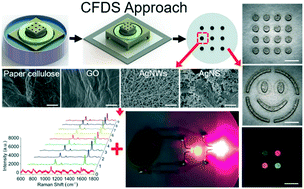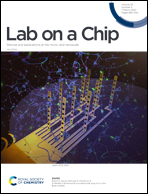Non-powered capillary force-driven stamped approach for directly printing nanomaterials aqueous solution on paper substrate†
Abstract
The recent boom of nanomaterials printing in the fields of biomedical engineering, bioanalysis and flexible electronics has greatly stimulated researchers' interest in printing technologies. However, specifically formulated nanomaterial inks have limited the types of printable nanomaterials. Here, a unique non-powered capillary force-driven stamped (CFDS) approach, combining a 3D-printed stamper with a paper substrate, is developed for directly printing patterned nanomaterials aqueous solution. The CFDS approach has two processes, including the loading process in which the capillary force of the stamper channel is stronger than gravity, and the deposition process, in which the synergistic action of the capillary force of the paper fibre tubes and gravity is approximately 20 times the capillary force of the stamper channel. Four additive-free nanomaterial aqueous solutions, including nanowires, nanosheets, nanostars and nanogels, are used to print patterns, and show slight diffusion and desired uniformity with a diffusion rate and roundness of 1.12 and 0.78, respectively, demonstrating the feasibility of this approach. Four kinds of nanogel with different fluorescence labels are simultaneously printed to challenge the approach and demonstrate its flexibility and scalability. The resolution of the approach is 0.3 mm. Without any post-processing, the stamped paper substrates directly serve as paper-based surface enhanced Raman scattering substrates with an enhancement factor of 4 × 106 and as electrodes with a resistance of 0.74 Ω, demonstrating their multi-functionality. Due to its general, flexible and scalable applicability, this simple, low-cost and non-powered approach could be widely applied to the personalized printing of nanomaterials on paper substrates.



 Please wait while we load your content...
Please wait while we load your content...